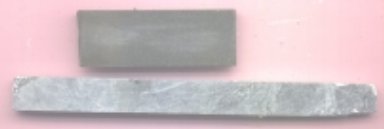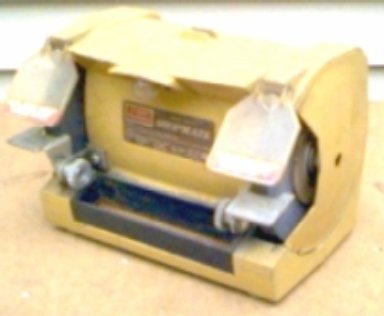Sharpening is an art requiring learning and practice. Often to remove nicks and to reshape or establish angles, files are used; followed with a coarser stone to smooth and shape edge. Final finishing is done by honing or whetting with oil to slow or water speed cutting. Each step produces a roll over at the edge, which must be removed by lightly working opposite side. Pressure is reduced gradually in succeeding steps. All cutting should be toward the edge. Testing can be done by lightly drawing edge lengthwise on a fingernail until no drag is felt. Hollow ground edges require special sharpeners or wheels. Light honing can touch up edges until concave section diminishes.
Unless you have acquired the knowledge to improve them, a thorough examination of the blade and edge contours should be made to enable duplicating these during sharpening. Often this will reveal clues as to the methods and tools to be used. There is no: "One size fits all". Some experimentation may be required using expendable items. Single blade tools can be corrected at the expense of a little blade width, but those with opposing blades may not align correctly, if too much material is removed. Often fulcrum type cutters have stops built in handles, which may be reduced to permit blades to meet properly. Remember more tool are worn out by over sharpening than from proper use.
In shaped stick and block forms, from very coarse to very fine, stones are useful in hand shaping metal and sharpening. Many builders have been seen edging dulled tools on sidewalks and bricks as an expedient. Some newer types have abrasives bonded to ceramics or plastics, such as the Sharpy with a coarse side for heavier shaping and a honing side for finishing.

Note Adjust brightness and contrast for optimum viewing.
STONES
Piece of fisherman's hook sharpener.
Arkansas slip, very fine grit stick.

Note: Adjust brightness and contrast for optimum viewing.
EXPENSIVE CHEF'S DIAMOND COATED BAR.
Mounted on wooden block.
Commonly used by meat cutters, cooks and chefs; the steel is an often tapered, round or oval, roughened steel bar with a hilt and handle, upon which knife edges are drawn to obtain a very sharp finish.

Note: Adjust brightness and contrast for optimum viewing.
OVAL STEEL 10"
With varying degrees of success, over the years, many gadgets have been developed to simplify sharpening home. kitchen, shop, garden and hobby implements. Most have have guides, to help maintain angles and some have formed edges of steel or abrasives. Early types had two sets of interleaved and slightly overlapping steel washers, between which a blade was drawn to produce a hollow ground type edge. Straight and curved steel or stone slivers were also mounted in bracket type metal holders. More recently various stone, ceramic, and diamond abrasive shapes are mounted in inexpensive plastic holders. Ceramic usually produces a honing action. Blades are usually drawn through the dies with light pressure, repeating as necessary. Some lines offer several different configurations for tapered, hollow ground, scissors and others. On some, only one side is done at a time, presenting the curl over problem. Many types can be found in kitchen, cookware or hardware stores. Caution should be exercised in selection , since alignment angles may not be correct for the blades in question. Take a sample with you to compare.

Note Adjust brightness and contrast for optimum viewing.
MODEL KNIFE BLADE SHARPENERS
Sharpy.
Edjer guide with Arkansas slip.

Note: Adjust brightness and contrast for optimum viewing.
ACCUSHARP
Several screw diver tip sharpeners or shapers have been offered which hold shank at an angle to refurbish and taper the blade face. However to be most effective, the face should be hollow ground to be parallel to the walls up to the slot top to eliminate upward force; which would be generated with a slanted wedge, when torque is applied. This upward force sometimes requires a heavy downward push to keep tip in slot. Next to improper fit, failure to keep tip in slot is the major source for slot and tip damage. This is noticed particularly, when using power screw drivers.
POWER SHARPENING
 Caution: As with all powered
cutting tools, suitable protection must be worn. Grinding is worse, since
in addition to flying work material chips, grains of abrasive are included.
Often very hot sparks are added to the mixture. Quasi-solid wheels demand
special care to guard then from shock. Hidden cracks may weaken them;
causing them to fly apart on spin-up. Never stand in the line of fire when
starting a grinder or you may regret it. Although abrasive accessories are
often offered for screw machines, their use is not recommended; since
ejected abrasives tend to collect on oiled ways and screws, eroding their
accuracy.
Caution: As with all powered
cutting tools, suitable protection must be worn. Grinding is worse, since
in addition to flying work material chips, grains of abrasive are included.
Often very hot sparks are added to the mixture. Quasi-solid wheels demand
special care to guard then from shock. Hidden cracks may weaken them;
causing them to fly apart on spin-up. Never stand in the line of fire when
starting a grinder or you may regret it. Although abrasive accessories are
often offered for screw machines, their use is not recommended; since
ejected abrasives tend to collect on oiled ways and screws, eroding their
accuracy.
The time honored tool for power sharpening was a treadle driven grinding wheel on which a well trained craftsman could grind almost any cutting tool by hand and eye. It turned slowly, avoiding heat build-up; the enemy of hardened edges. Many tool sharpeners and machinists still shape tool blanks and edge special tools on electrically powered wheel grinders , but with a container of water on hand for quick cooling. Rims of wheels produce hollow ground edges, while the sides are used for straighter edges. Most grinders have both a coarse and a fine wheel. A little difficult to learn and practice, the secret is to keep the blade moving steadily across the wheel, while maintaining the desired angle. Rests are are usually provided to help guide the movement. Final honing and touch-up is done by hand, as described above.
Various holders and fixtures are available for sharpening everything from drill and lathe bit to giant shears, but none are useful for hobby tools. The smallest drill bit guide was 1/16". But attempts to sharpen smaller bits would probably break them. Most are just too expensive.
A small grinder is handy near the workbench for sharpening and shaping metal parts. Some fancier models have built-in guides for sharpening blades and drill bits, but they are too large for most modelling sized items.

Note: adjust brightness and contrast for optimum viewing.
SMALL 4" BENCH GRINDER.
Several cutlery sharpeners are available at kitchen stores with diamond grinders, Although they are designed for larger knives, they can be used with hobby knives. Appropriated from my wife, the one shown has three sets of grinders which move in an orbital motion. The covered set at the left is for rough shaping, the next is for sharpening and the last is equivalent to stropping. Magnets in the outer side of vees hold blade at proper angle for cutlery; as the blade is drawn through. The edge produced is not hollow ground, but is a more durable stepped wedge, Due to the short length of #11 blades positioning is very tricky. Using the guide produces a too blunt angle, but by placing against the opposite plastic guard, an excellent edge for trimming, plastic or metal, flash can be achieved, after a bit of experimentation. But it does not cut as well as a new hollow ground blade on delicate jobs.

Note: Adjust brightness and contrast for optimum viewing.
CUTLERY SHARPENER.
With very fine grits, power sanders can be used for shaping edges prior to honing. It has been rumored that some people use fine rotary tool stones effectively. Apparently power sharpeners have not come down to the modelling size yet.
BACK TO HAND ABRASIVE SHAPING
BACK TO METHODS INDEX
BACK TO TOOLS INDEX
